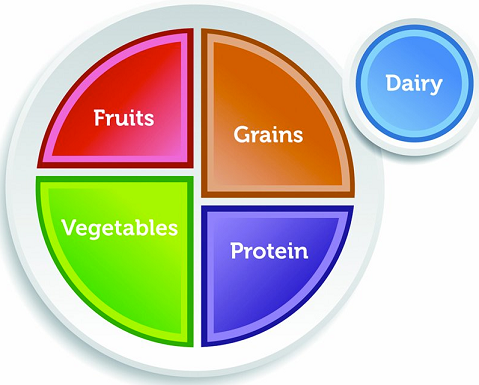Food Plate
In this lesson you will learn about each section of the food plate. You will play games and take quizes to help you learn information. As you go through this lesson you will have an oppurtiunity to earn digital badges. If you are having trouble through out the lesson don't be afraid to ask for help.
The food plate is set by the United States Department of Agriculture (USDA). The food plate is broken into five categories which are fruits, vegetables, grains, protein, and dairy. The USDA has put out information on what kinds of foods are in each category and how much of that category our plate should be composed of each time we eat. You may be wondering why the food plate is important by now. The food plate is important because it helps us stay in shape and healthy.

Fruit Category
The fruit category on the plate is marked with a red background. The fruit category is located in the top left side of the food plate. To be in the fruit category the food must be a fruit or 100% fruit juice. Fruits can be fresh, frozen, canned, or dried and doesn't always have to be whole they can also be cut-up or pureed. Per the United States Department of Agriculture (USDA) 10% of your plate each time you eat should be fruits. Some examples of fruits are melons, berries, grapes, starfruit, kiwi, mangoes, nectarines, apples, oranges, apricots, bananas, cherries, pineapples, plums, pomegranate, grapefruit, lemons, and prunes.
 |
Click the card deck to view a card. Drag the card from the bottom to the correct category. |
|
This content requires JavaScript enabled.
|
|
Vegetable Category
The vegetable category on the plate is marked with a green background. The vegetable category is located in the lower left side of the food plate. To be in the vegetable category the food must be a vegetable or 100% vegetable juice. Vegetables can be raw or cooked; fresh, canned, frozen, or dehydrated/dried and don't always have to be whole they can also be cut-up or mashed. Per the United States Department of Agriculture (USDA) 40% of your plate each time you eat should be vegetables. Some examples of vegetables are broccoli, leafy greens, watercress, squash (pumpkins, zucchini, yellow summer crockneck) , peppers (bell, ghost, jalapeño), potatoes, tomatoes, plantains, water chestnuts, kidney beans, lenntils, soybeans, avocado, brussel sprouts, cucumbers, onions, and garlic.
 |
Solve the crossword puzzle. |
|
This content requires JavaScript enabled.
|
|
Grains Category
The grains category on the plate is marked with an orange background. The grains category is located in the top right side of the food plate. To be in the grains category the food must be made of wheat, oats, cornmeal, rice, barley or another cereal grain. The grains category is divided up into two groups, whole grains and refined grains. Whole grains contain the entire grain kernel and refined grains have been milled. Milled is a process that removes the bran and germ. The grain kernel is made of the bran, germ, and endosperm. Per the United States Department of Agriculture (USDA) 30% of your plate each time you each should be grains. Some examples of whole grains are brown rice, buckwheat, oatmeal, popcorn, whole wheat bread, whole wheat pasta, and wild rice. Some examples of refined grains are cakes, cookies, grits, pancakes, pie, pretzels, white bread, and white rice.
 |
Click and drag to highlight a found word from the list. |
|
This content requires JavaScript enabled.
|
|
Protein Category
The protein category on the plate is marked with a purple background. The protein category is located in the lower right side of the food plate. To be in the protein category the food must be made from meat, poultry, seafood, beans, peas, eggs, processed soy products, nuts and seeds. Per the United States Department of Agriculture (USDA) 20% of your plate each time you eat should be proteins. Some examples of proteins are almonds, peanuts, pumpkin seeds, canned fish, shellfish, black beans, kidney beans, bison, beef, chicken, ham, pork, sausage, turkey, and tofu.
 |
Drag the items from the bottom to the slots on the right. |
|
This content requires JavaScript enabled.
|
|
Dairy Category
The dairy category on the plate is marked with a blue background. The dairy category is not really located on the plate it is located to the upper right edge of the food plate. To be in the dairy category the food must be made of fluid milk products and foods made from milk. Per the United States Department of Agriculture (USDA) 8 ounces or 1 glass of your plate each time you eat should be dairy. Some examples of foods in the dairy category are milk, pudding, ice cream, smoothies, yogurt, sherbet, and cheese.
 |
Select the correct items. Click the bottom right arrow to go to the next set. Click the checkmark (available on the last set) to submit all your answers. |
|
This content requires JavaScript enabled.
|
|

